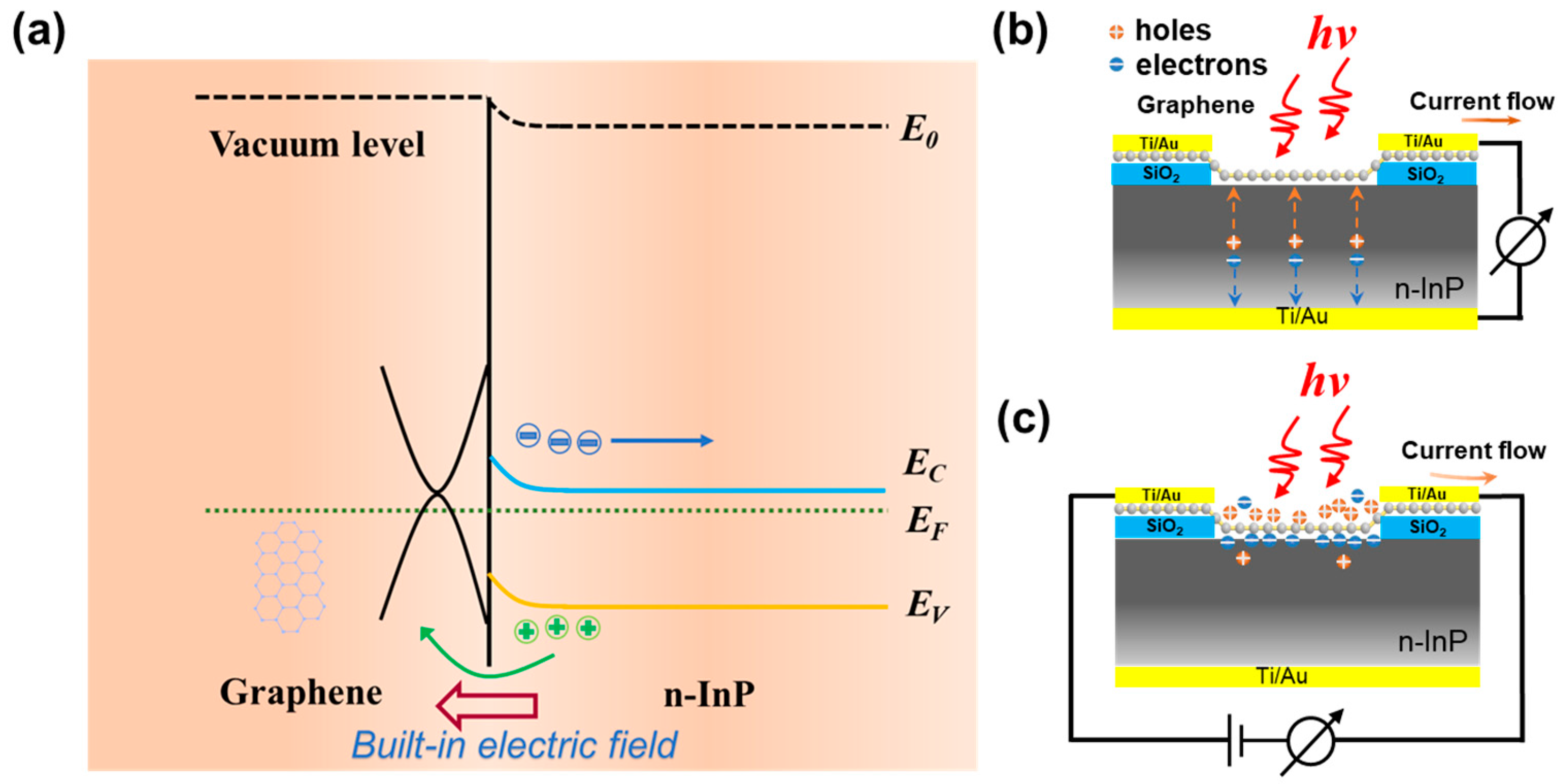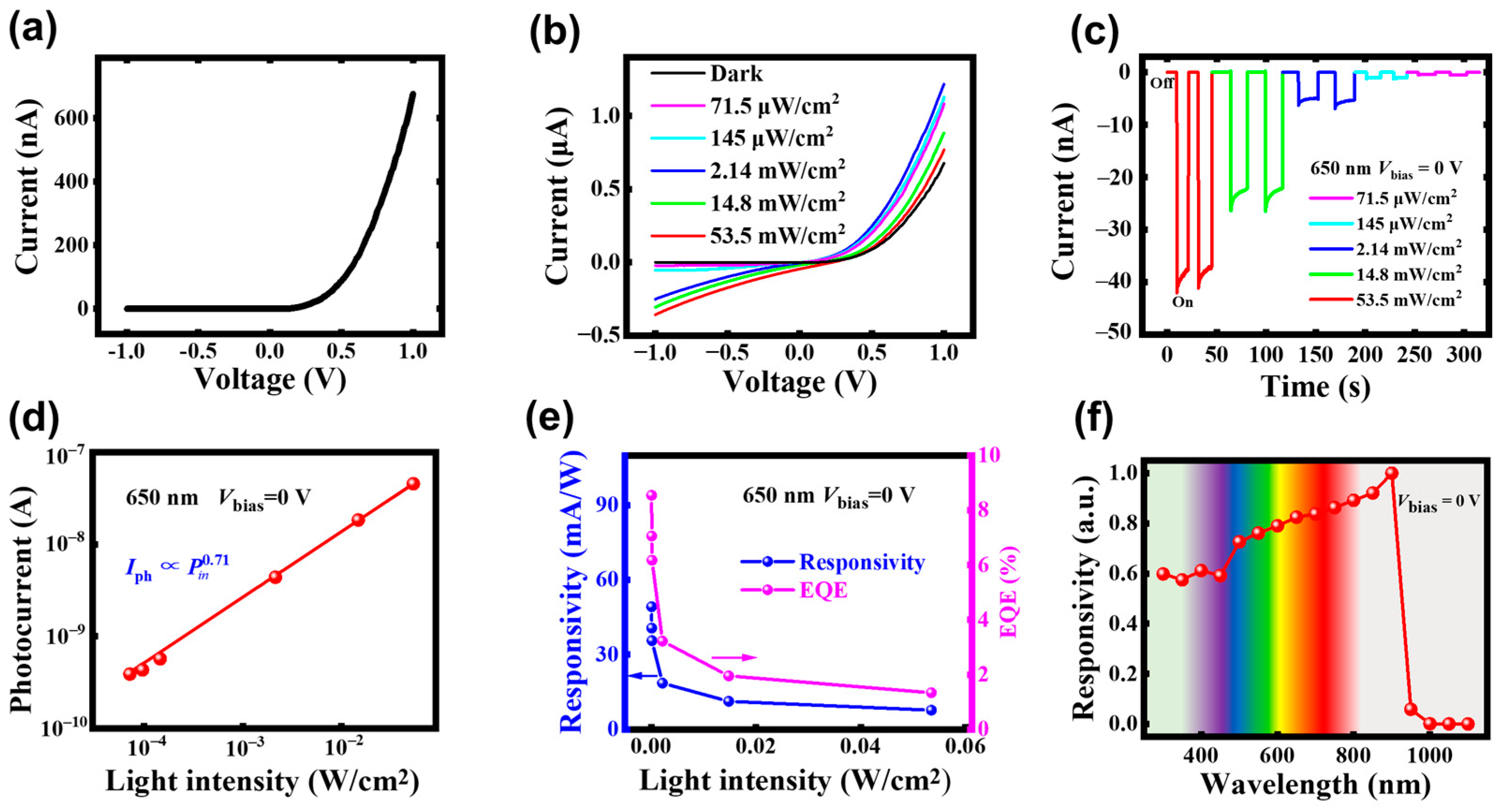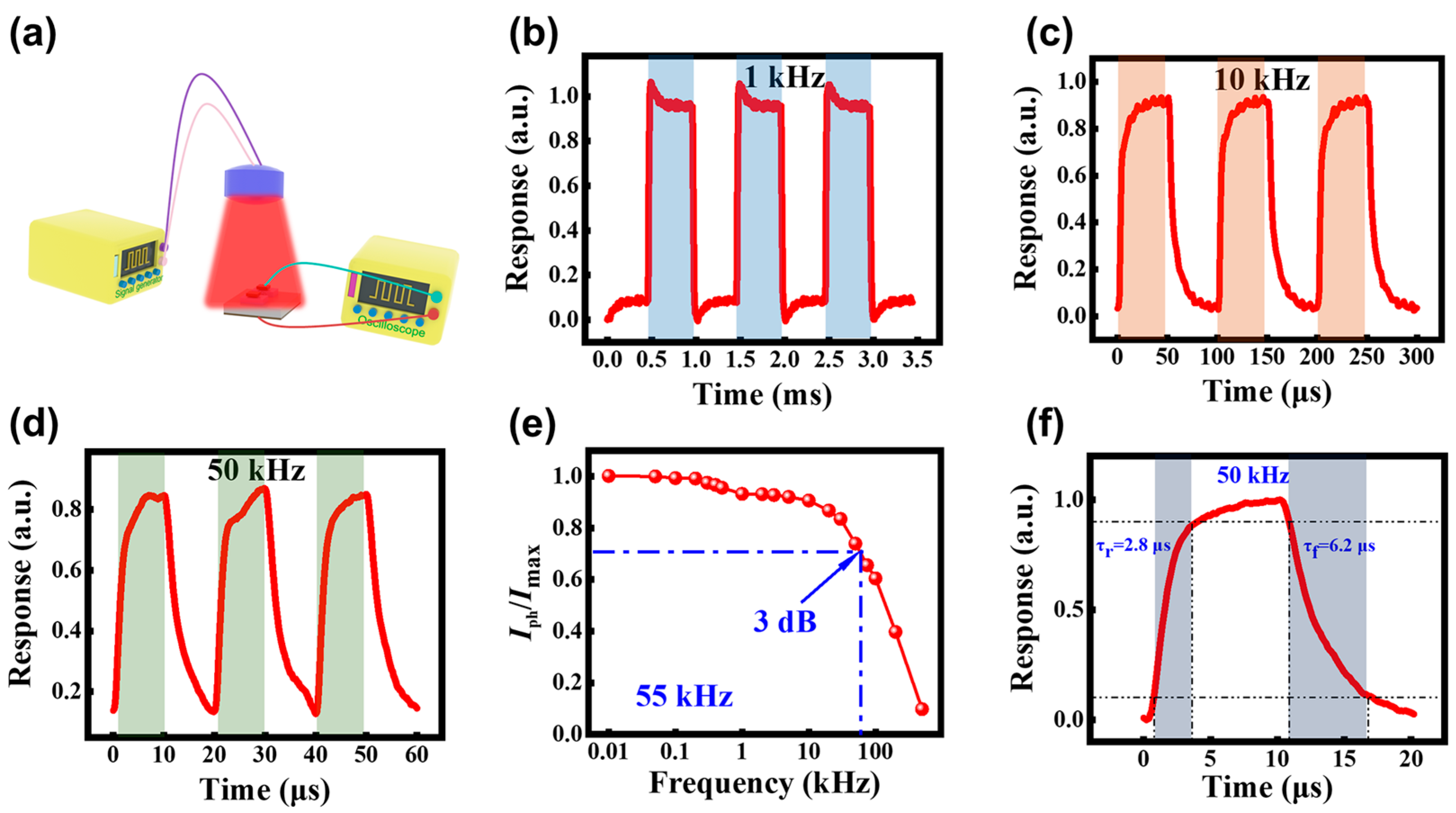UV-Vis-NIR Broadband Dual-Mode Photodetector Based on Graphene/InP Van Der Waals Heterostructure
Abstract
:1. Introduction
2. Materials and Methods
3. Results and Discussion
3.1. SEM Images and Raman Spectra Analysis
3.2. Working Principle of Graphene/InP Heterostructure DmPD
3.3. Optoelectronic Properties of the DmPD Working in Photovoltaic Mode
3.4. Optoelectronic Properties of the DmPD Working in Photoconductive Mode
3.5. Performance Comparison of Graphene/InP Heterostructure Photodetectors
4. Conclusions
Supplementary Materials
Author Contributions
Funding
Institutional Review Board Statement
Informed Consent Statement
Data Availability Statement
Conflicts of Interest
References
- Guo, Z.; Wang, J.; Du, J.; Wu, D.; Zeng, L.; Tsang, Y.H.; Wu, D.; Wang, Y.; Ding, Y.; Lin, P. Self-driven Te0.65Se0.35/GaAs SWIR photovoltaic with spectral response to 1.55 μm for broadband imaging and optical communication. Nano Energy 2025, 133, 110452. [Google Scholar] [CrossRef]
- Kang, Y.; Hou, X.; Zhang, Z.; Tang, J.; Lin, F.; Li, K.; Hao, Q.; Wei, Z. Ultrahigh-performance and broadband photodetector from visible to shortwave infrared band based on GaAsSb nanowires. Chem. Eng. J. 2024, 501, 157392. [Google Scholar] [CrossRef]
- Zhang, C.; Peng, S.; Ouyang, Y.; Han, J.; Li, C.; Wei, Y.; Jiang, Y.; Dong, M.; Wang, J. Broadband self-powered MoS2/PdSe2/WSe2 PSN heterojunction photodetector for high-performance optical imaging and communication. Opt. Express 2024, 32, 38136–38146. [Google Scholar] [CrossRef] [PubMed]
- Han, Y.; Jiao, S.; Zhang, X.; Rong, P.; Zhao, Y.; Jiang, D.; He, W.; Wang, D.; Gao, S.; Wang, J. Bipolar Modulation in a Self-Powered Ultra-Wide Photodetector Based on Bi2Se3/AlInAsSb Heterojunction for Wavelength-Sensitive Imaging and Encrypted Optical Communication. Adv. Mater. 2024, 37, 2416935. [Google Scholar] [CrossRef]
- Osicheva, A.; Sych, D. Scalable High-Resolution Single-Pixel Imaging via Pattern Reshaping. Sensors 2024, 24, 4689. [Google Scholar] [CrossRef]
- Zhou, H.; Tan, M.; Wang, Y.; Wang, X.; Chen, J.; Wang, X.; Chu, X.; Cong, L. High-performance self-powered broadband imaging photodetector based on single crystal-CsPbBr3/single crystal-β-Ga2O3 heterojunction. Opt. Express 2024, 32, 45348–45356. [Google Scholar] [CrossRef]
- Ren, X.; Li, X.; He, X.; An, X.; Li, Y.; Gao, B.; Gao, F.; Zhang, J.; Hu, P. Self-powered broadband photodetectors based on Bi2O2Se with asymmetric contact areas. Chem. Eng. J. 2024, 496, 153937. [Google Scholar] [CrossRef]
- Zhu, H.; Li, Q.; Tao, C.; Hong, Y.; Xu, Z.; Shen, W.; Kaur, S.; Ghosh, P.; Qiu, M. Multispectral camouflage for infrared, visible, lasers and microwave with radiative cooling. Nat. Commun. 2021, 12, 1805. [Google Scholar] [CrossRef]
- Lee, D.; Jeong, S.; Moon, S.; Yang, M.; Kim, S.H.; Kim, D.; Lee, S.Y.; Lee, I.S.; Jeon, D.W.; Park, J.H.; et al. Giant Colloidal Quantum Dot/α-Ga2O3 Heterojunction for High Performance UV–Vis–IR Broadband Photodetector. ACS Nano 2024, 18, 34741–34749. [Google Scholar] [CrossRef]
- He, Z.; Duan, H.; Zeng, J.; Zhou, J.; Zhong, X.; Wu, Z.; Ni, S.; Jiang, Z.; Xie, G.; Lee, J.Y.; et al. Perovskite retinomorphic image sensor for embodied intelligent vision. Sci. Adv. 2025, 11, eads2834. [Google Scholar] [CrossRef]
- Joyce, H.J.; Boland, J.L.; Davies, C.L.; Baig, S.A.; Johnston, M.B. A review of the electrical properties of semiconductor nanowires: Insights gained from terahertz conductivity spectroscopy. Semicond. Sci. Technol. 2016, 31, 103003. [Google Scholar] [CrossRef]
- Lin, C.H.; Liu, C.W. Metal-insulator-semiconductor photodetectors. Sensors 2010, 10, 8797–8826. [Google Scholar] [CrossRef] [PubMed]
- Mokkapati, S.; Jagadish, C. III-V compound SC for optoelectronic devices. Mater. Today 2009, 12, 22–32. [Google Scholar] [CrossRef]
- Hu, F.; Dai, X.; Zhou, Z.; Kong, X.; Sun, S.; Zhang, R.; Wang, S.; Lu, M.; Sun, J. Black silicon Schottky photodetector in sub-bandgap near-infrared regime. Opt. Express 2019, 27, 3161–3168. [Google Scholar] [CrossRef]
- Scattolo, E.; Cian, A.; Petti, L.; Lugli, P.; Giubertoni, D.; Paternoster, G. Near infrared efficiency enhancement of silicon photodiodes by integration of metal nanostructures supporting surface plasmon polaritrons. Sensors 2023, 23, 856. [Google Scholar] [CrossRef]
- Xu, R.; Sun, Y.; Zhu, Y.; Wang, F.; Wang, J.; Cheng, L.; Xu, K.; Qian, Y. Tunable surface band bending enables switchable photoconductance of colloidal InSb nanowires for self-powered and broadband photodetectors with fast response. Appl. Surf. Sci. 2024, 670, 160690. [Google Scholar] [CrossRef]
- Yang, Z.; Ma, S.; Shi, Y.; Hao, X.; Shang, L.; Han, B.; Qiu, B.; Xu, B. Facile sulfur-assisted synthesis of GaAs nanowires/si heterojunctions for broadband self-powered photodetector. Opt. Mater. 2024, 150, 115183. [Google Scholar] [CrossRef]
- Park, H.; Kim, Y.J.; Kim, M. Near-unity quantum efficiency of self-powered broadband photovoltaic black Si photodetectors with passivated Schottky junction. Nanotechnology 2024, 35, 505204. [Google Scholar] [CrossRef]
- Yue, L.; Shi, Y.L.; Qiang, S.; Sun, N.F.; Qin, J.K.; Zhen, L.; Xu, C.Y. Space-confined synthesis of two-dimensional InP crystals for high-performance self-powered Schottky photodiode. Appl. Mater. Today 2024, 40, 102376. [Google Scholar] [CrossRef]
- Xie, H.; Shen, X.; Ge, Y.; Xu, Z.; Liu, Z.; Ma, Y.; Na, W.; Jin, D.; Zhang, W. A SiGe/Si Heterojunction Phototransistor for High Sensitivity Light Detection. IEEE Trans. Electron. Dev. 2024, 71, 6857–6863. [Google Scholar] [CrossRef]
- Dai, M.; Zhang, X.; Wang, Q. 2D materials for photothermoelectric detectors: Mechanisms, materials, and devices. Adv. Funct. Mater. 2024, 34, 2312872. [Google Scholar] [CrossRef]
- Nasir, S.; Johrin, N.; Low, W.; Moh, P.Y.; bin Megat Hasnan, M.M.I.; Ghosh, B.K.; Chee, F.P. Development of Graphene-based Photodiode Device: Synthesis, Deposition, and Characterization. ECS J. Solid State Sci. Technol. 2024, 13, 121001. [Google Scholar]
- Scagliotti, M.; Salvato, M.; De Crescenzi, M.; Kovalchuk, N.G.; Komissarov, I.V.; Prischepa, S.L.; Catone, D.; Di Mario, L.; Boscardin, M.; Crivellari, M.; et al. Femtosecond light pulse response of photodetectors based on Graphene/n-Si heterojunctions. Carbon 2019, 152, 643–651. [Google Scholar] [CrossRef]
- Tian, H.; Hu, A.; Liu, Q.; He, X.; Guo, X. Interface-Induced High Responsivity in Hybrid Graphene/GaAs Photodetector. Adv. Opt. Mater. 2020, 8, 1901741. [Google Scholar]
- Wu, J.; Yang, Z.; Qiu, C.; Zhang, Y.; Wu, Z.; Yang, J.; Lu, Y.; Li, J.; Yang, D.; Hao, R.; et al. Enhanced performance of a graphene/GaAs self-driven near-infrared photodetector with upconversion nanoparticles. Nanoscale 2018, 10, 8023–8030. [Google Scholar] [CrossRef]
- Cao, G.; Wang, F.; Peng, M.; Shao, X.; Yang, B.; Hu, W.; Li, X.; Chen, J.; Shan, Y.; Wu, P.; et al. Multicolor Broadband and Fast Photodetector Based on InGaAs-Insulator-Graphene Hybrid Heterostructure. Adv. Electron. Mater. 2020, 6, 1901007. [Google Scholar]
- Yang, Q.; Wu, Q.; Luo, W.; Yao, W.; Yan, S.; Shen, J. InGaAs/graphene infrared photodetectors with enhanced responsivity. Mater. Res. Express 2019, 6, 116208. [Google Scholar] [CrossRef]
- Wu, J.; Qiu, C.; Feng, S.; Yao, T.; Yan, Y.; Lin, S. A synergetic enhancement of localized surface plasmon resonance and photo-induced effect for graphene/GaAs photodetector. Nanotechnology 2020, 31, 105204. [Google Scholar]
- Fang, H.; Hu, W. Photogating in low dimensional photodetectors. Adv. Sci. 2017, 4, 1700323. [Google Scholar] [CrossRef]
- Han, J.; Deng, W.; Hu, F.; Han, S.; Wang, Z.; Fu, Z.; Zhou, H.; Yu, H.; Gou, J.; Wang, J. 2D Materials-Based Photodetectors with Bi-Directional Responses in Enabling Intelligent Optical Sensing. Adv. Funct. Mater. 2025, 2423360. [Google Scholar] [CrossRef]
- Zeng, W.; Duan, Z.; Bu, Y.; Tang, X.; Yang, J.; Yuan, Z.; Jiang, Y.; Tai, H. Advances in Bipolar Photodetectors: Working Principles, Constructions, and Applications. Laser Photonics Rev. 2025, 2402163. [Google Scholar] [CrossRef]
- An, X.; Liu, F.; Jung, Y.J.; Kar, S. Tunable graphene–silicon heterojunctions for ultrasensitive photodetection. Nano Lett. 2013, 13, 909–916. [Google Scholar] [CrossRef] [PubMed]
- Xu, J.; Yu, J.; Liao, J.; Yang, X.; Wu, C.; Wang, L.; Xie, C.; Luo, L. Opening the Band Gap of Graphene via Fluorination for High-Performance Dual-Mode Photodetector Application. ACS Appl. Mater. Inter. 2019, 11, 21702–21710. [Google Scholar] [CrossRef] [PubMed]
- Hu, L.; Dong, Y.; Deng, J.; Xie, Y.; Ma, X.; Qian, F.; Wang, Q.; Fu, P.; Xu, C. High responsivity graphene-InGaAs near-infrared photodetector realized by hole trapping and its response saturation mechanism. Opt. Express 2021, 29, 23234–23243. [Google Scholar] [CrossRef]
- Malard, L.M.; Pimenta, M.A.; Dresselhaus, G.; Dresselhaus, M.S. Raman spectroscopy in graphene. Phys. Rep. 2009, 473, 51–87. [Google Scholar] [CrossRef]
- Wu, J.; Lin, M.; Cong, X.; Liu, H.; Tan, P. Raman spectroscopy of graphene-based materials and its applications in related devices. Chem. Soc. Rev. 2018, 47, 1822–1873. [Google Scholar] [CrossRef]
- Wang, P.; Li, X.; Xu, Z.; Wu, Z.; Zhang, S.; Xu, W.; Zhong, H.; Li, E.; Luo, J.; Yu, Q.; et al. Tunable graphene/indium phosphide heterostructure solar cells. Nano Energy 2015, 13, 509–517. [Google Scholar] [CrossRef]
- Lin, S.; Wang, P.; Li, X.; Wu, Z.; Xu, Z.; Zhang, S.; Xu, W. Gate tunable monolayer MoS2/InP heterostructure solar cells. Appl. Phys. Lett. 2015, 107, 153904. [Google Scholar] [CrossRef]
- Xu, J.; Wang, Q.; Shen, M.; Yang, Y.; Liu, H.; Yuan, X.; Zhang, Y.; Liu, K.; Cai, S.; Huang, Y.; et al. Demonstration of a 3D-Assembled Dual-Mode Photodetector Based on Tubular Graphene/III–V Semiconductors Heterostructure and Coplanar Three Electrodes. ACS Nano 2024, 18, 14978–14988. [Google Scholar] [CrossRef]
- Xie, C.; Xu, J.; Wang, Y.; Yang, W.; Zhao, Y.; Wang, S.; Liu, H.; Wang, Q.; Yuan, X.; Zeng, W.; et al. Self-Powered Short-Wavelength Infrared Photodetectors Composed of MXene/InGaAs Heterostructures. IEEE Trans. Electron. Devices 2022, 69, 6201–6205. [Google Scholar] [CrossRef]
- Xie, C.; You, P.; Liu, Z.; Li, L.; Yan, F. Ultrasensitive broadband phototransistors based on perovskite/organic-semiconductor vertical heterojunctions. Light Sci. Appl. 2017, 6, e17023. [Google Scholar] [PubMed]
- Xie, C.; Mak, C.; Tao, X.; Yan, F. Photodetectors based on two-dimensional layered materials beyond graphene. Adv. Funct. Mater. 2017, 27, 1603886. [Google Scholar]
- Wang, F.; Zhang, T.; Xie, R.; Wang, Z.; Hu, W. How to characterize figures of merit of two-dimensional photodetectors. Nat. Commun. 2023, 14, 2224. [Google Scholar] [PubMed]
- Luo, L.; Zou, Y.; Ge, C.; Zheng, K.; Wang, D.; Lu, R.; Zhang, T.; Yu, Y.; Guo, Z. A surface plasmon enhanced near-infrared nanophotodetector. Adv. Opt. Mater. 2016, 4, 763–771. [Google Scholar] [CrossRef]
- Zhang, T.; Chen, J. Graphene/InP Schottky junction near-infrared photodetectors. Appl. Phys. A 2020, 126, 832. [Google Scholar]
- Chen, H.; Chen, J. High-performance self-driven near-infrared photodetector based on single-walled carbon nanotube/graphene/Al2O3/InP. Mater. Today Commun. 2022, 33, 104780. [Google Scholar] [CrossRef]
- Zhang, Y.; Chen, J. Performance of graphene/P-InP Schottky diode enhanced by silver nanoparticles. Sens. Actuator A Phys. 2022, 346, 113862. [Google Scholar]
- Chen, H.; Chen, J. High performance near-infrared photodetector based on PbS quantum dots and graphene. Sens. Actuator A Phys. 2022, 339, 113508. [Google Scholar]







| Device Structure | Measurement Conditions | R (A/W) | D* (Jones) | τr/τf | Ref. |
|---|---|---|---|---|---|
| Graphene/n-InP heterostructure DmPD (Photovoltaic mode) | Vbias = 0 V | 0.049 | 4.09 × 1011 | 2.8 μs/6.2 μs | This work |
| λ = 650 nm | |||||
| Graphene/n-InP heterostructure DmPD (Photoconductive mode) | Vbias = 1 V | 162.5 | 1.76 × 1010 | 61 ms/4 ms | This work |
| λ = 650 nm | |||||
| Graphene/n-InP photodetector | Vbias = 0 V | 0.046 | 3.62 × 109 | 25.9 μs/43.3 μs | [43] |
| λ = 980 nm | |||||
| Graphene/n-InP with silica @AuNR photodetector | Vbias = 0 V | 0.140 | 1.1 × 1010 | 441 ns/433 ns | [44] |
| λ = 980 nm | |||||
| Graphene/p-InP/Al2O3 photodetector | Vbias = 0 V | 0.002 | 1.2 × 1010 | / | [45] |
| λ = 808 nm | |||||
| SWCNT/graphene/Al2O3/p-InP photodetector | Vbias = 0 V | 0.154 | 1.3 × 1012 | 40 μs/180 μs | [46] |
| λ = 808 nm | |||||
| Ag NPs/ graphene/p-InP photodetector | Vbias = 0 V | 0.008 | 1.2 × 1010 | 246.8 μs/800 μs | [47] |
| λ = 808 nm | |||||
| PbS (TBAI)/Graphene/ Al2O3/p-InP photodetector | Vbias = 1.1 V | 0.145 | 9.7 × 1010 | 11 μs/76 μs | [48] |
| λ = 808 nm |
Disclaimer/Publisher’s Note: The statements, opinions and data contained in all publications are solely those of the individual author(s) and contributor(s) and not of MDPI and/or the editor(s). MDPI and/or the editor(s) disclaim responsibility for any injury to people or property resulting from any ideas, methods, instructions or products referred to in the content. |
© 2025 by the authors. Licensee MDPI, Basel, Switzerland. This article is an open access article distributed under the terms and conditions of the Creative Commons Attribution (CC BY) license (https://creativecommons.org/licenses/by/4.0/).
Share and Cite
Shen, M.; Liu, H.; Wang, Q.; Ye, H.; Yuan, X.; Zhang, Y.; Wei, B.; He, X.; Liu, K.; Cai, S.; et al. UV-Vis-NIR Broadband Dual-Mode Photodetector Based on Graphene/InP Van Der Waals Heterostructure. Sensors 2025, 25, 2115. https://doi.org/10.3390/s25072115
Shen M, Liu H, Wang Q, Ye H, Yuan X, Zhang Y, Wei B, He X, Liu K, Cai S, et al. UV-Vis-NIR Broadband Dual-Mode Photodetector Based on Graphene/InP Van Der Waals Heterostructure. Sensors. 2025; 25(7):2115. https://doi.org/10.3390/s25072115
Chicago/Turabian StyleShen, Mingyang, Hao Liu, Qi Wang, Han Ye, Xueguang Yuan, Yangan Zhang, Bo Wei, Xue He, Kai Liu, Shiwei Cai, and et al. 2025. "UV-Vis-NIR Broadband Dual-Mode Photodetector Based on Graphene/InP Van Der Waals Heterostructure" Sensors 25, no. 7: 2115. https://doi.org/10.3390/s25072115
APA StyleShen, M., Liu, H., Wang, Q., Ye, H., Yuan, X., Zhang, Y., Wei, B., He, X., Liu, K., Cai, S., Huang, Y., & Ren, X. (2025). UV-Vis-NIR Broadband Dual-Mode Photodetector Based on Graphene/InP Van Der Waals Heterostructure. Sensors, 25(7), 2115. https://doi.org/10.3390/s25072115






